If you find yourself torn between Constant Contact and Campaign Monitor and are struggling to decide which tool to commit to, this detailed guide is specifically for you.
When it comes to features, Constant Contact excels in compatibility with other marketing channels, good automation features, and customer support.
On the other hand, Campaign Monitor stands out with its modern email designs, integrations and easy-to-use interface.
Both tools have their merits, but how do their features compare when pitted against each other?
Let’s dive in and find out in this in-depth Constant Contact vs Campaign Monitor review.
Constant Contact vs Campaign Monitor: Quick overview
Constant Contact or Campaign Monitor? We’ll expose their differences in detail in the later part of the post. In the meantime, here’s a high-level overview of the most important email marketing features:
Constant Contact vs Campaign Monitor comparison: Feature by feature
Having examined the overall capabilities of Constant Contact and Campaign Monitor, it’s time to delve into a detailed comparison of these two platforms. Let’s explore how they stack up against each other in the following key areas:
- Ease of getting started
- Building an email campaign
- Marketing automation
- Signup forms and landing pages
- Segmentation
- Analytics
- Customer support
- Integrations
- Compatibility with other marketing channels
By comparing these key areas, users can make an informed decision based on their specific needs and priorities when choosing between Constant Contact and Campaign Monitor.
Ease of getting started
The signup process for both Constant Contact and Campaign Monitor is straightforward and hassle-free. When testing them out, we didn’t encounter any issues. In terms of usability, we found both tools intuitive and easy to navigate, and our initial impression of their user interfaces was positive.
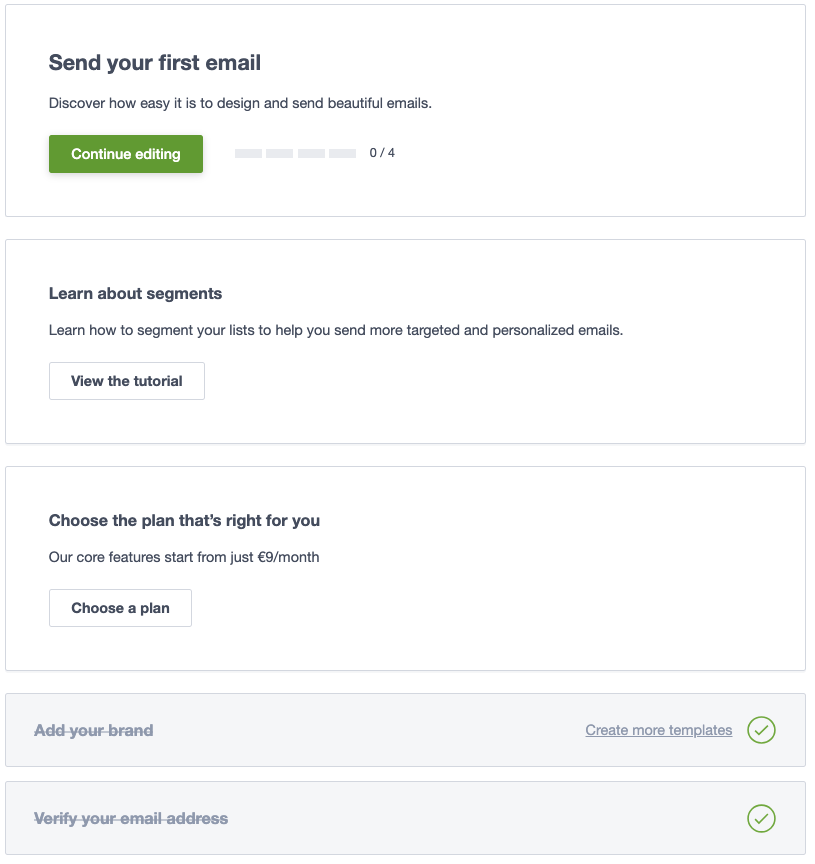
However, we faced difficulties locating the signup forms and creating new segments in Campaign Monitor. It took us a few minutes of confusion and searching within the tool before going to the Help Center for guidance. This wasn’t the case with Constant Contact, where the process was more straightforward and user-friendly.
Additionally, Constant Contact stands out by offering a highly-welcomed feature: a 30-day refund window on any of its paid plans. This is a bold move that demonstrates their confidence in their service and provides added peace of mind to users.
Constant Contact emerges as the winner in this round. Our overall experience in getting started with Constant Contact was smoother and more positive than Campaign Monitor, making it the preferred choice in terms of ease of use and customer-friendly policies.
Building an email campaign
Constant Contact’s email-building wizard slightly differs from what we find in Mailchimp, Klaviyo, or Omnisend. For starters, there are fewer steps. The campaign name, subject line, and preheader are located inside the email design builder, not listed as part of the steps. This is a bit unusual, but not bad. You’ll need a second to figure this out.
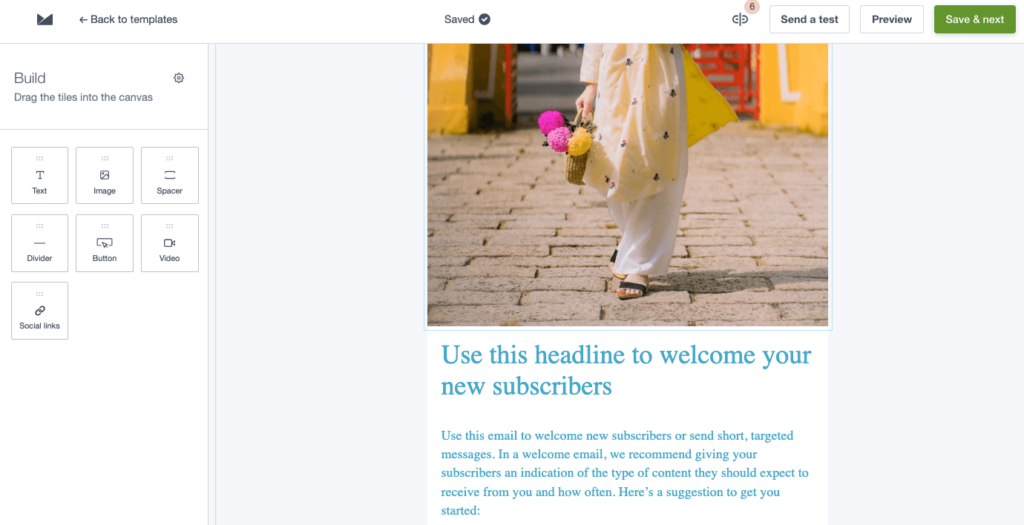
In contrast, Campaign Monitor is more clear-cut with getting started. Plus, there’s ample guidance so you won’t miss a thing. The subject line and preheader have distinct buttons that enable personalization. You can add emojis, and even get ideas for your subject line.
What about the email builder itself?
Constant Contact’s email builder is easy to use. It has very user-centric navigation and helpful content layouts to create an aesthetic email. On paid plans, there’s an extensive library of free and premium images available for use. Trial users only have access to free images.
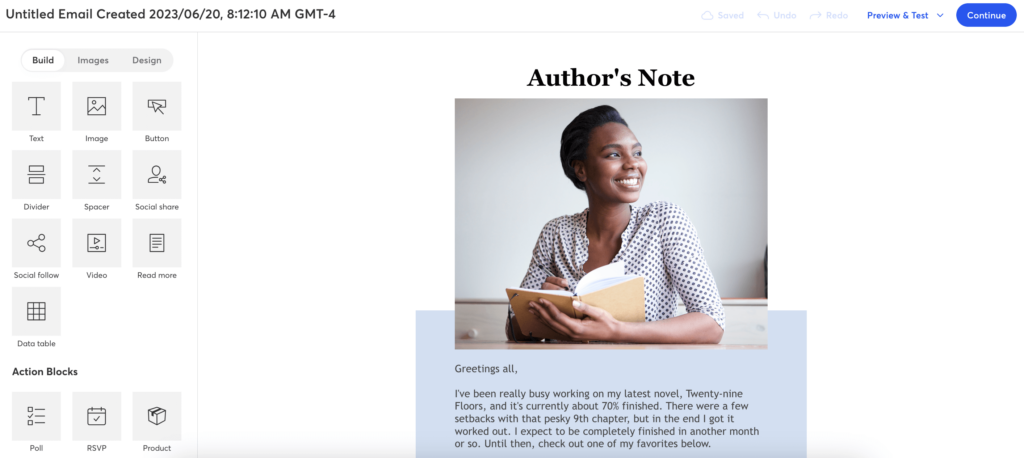
In comparison, Campaign Monitor’s email builder is quite limited. The builder doesn’t include product elements, dynamic recommenders, quizzes, or similar features. It primarily offers essential elements such as images, text, buttons, dividers, and a few others.
As for email templates, Constant Contact provides 100s of email templates, with a mix of outdated and visually appealing options that are suitable for specific occasions. They offer numerous templates for events like back-to-school, Black Friday, Christmas, Father’s Day, and various other occasions.
Campaign Monitor offers 120 good-looking templates for various use cases, which is decent but fewer compared to Constant Contact. You can use any templates for regular campaigns, basic automation, and A/B tests.
This round is a tie. Both tools have good-enough features for building an email campaign but lack specialized features for ecommerce marketers.
Marketing automation
Constant Contact has a good-looking, user-friendly marketing automation functionality. The standard titles of functions make it easy to work through. Here you get 15 marketing automation templates. These templates are suggestions and they come logic-ready with copy inspiration. You only have to add your business logo and edit the details as necessary.
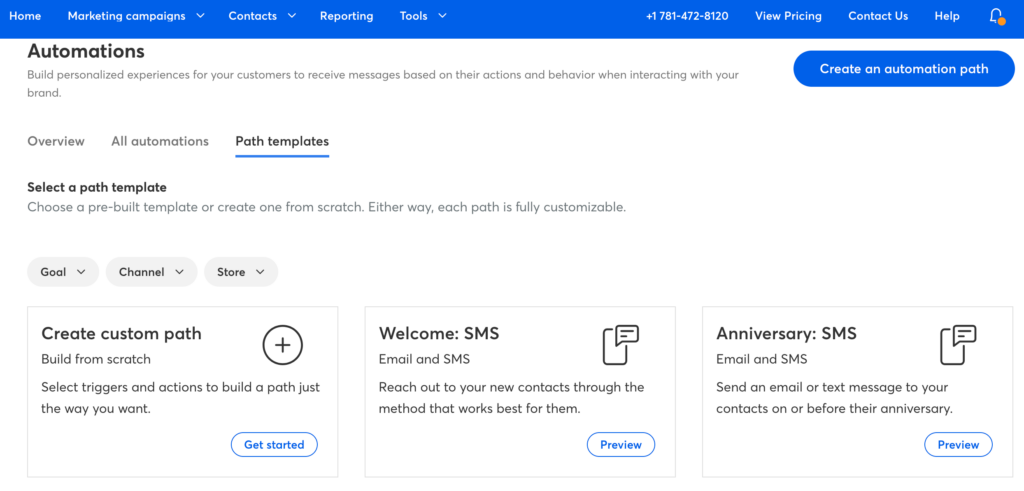
Constant Contact covers the following typical ecommerce scenarios for automated emails:
- Welcoming new subscribers
- Sending offers
- Thank-you messages
- Re-engaging dormant customers
- Congratulating contacts
- Sending reminders
- Targeting specific interests
- Recovering revenue
- Showing items in the cart
- Requesting reviews
- Cross-selling
- Wishing subscribers a happy birthday
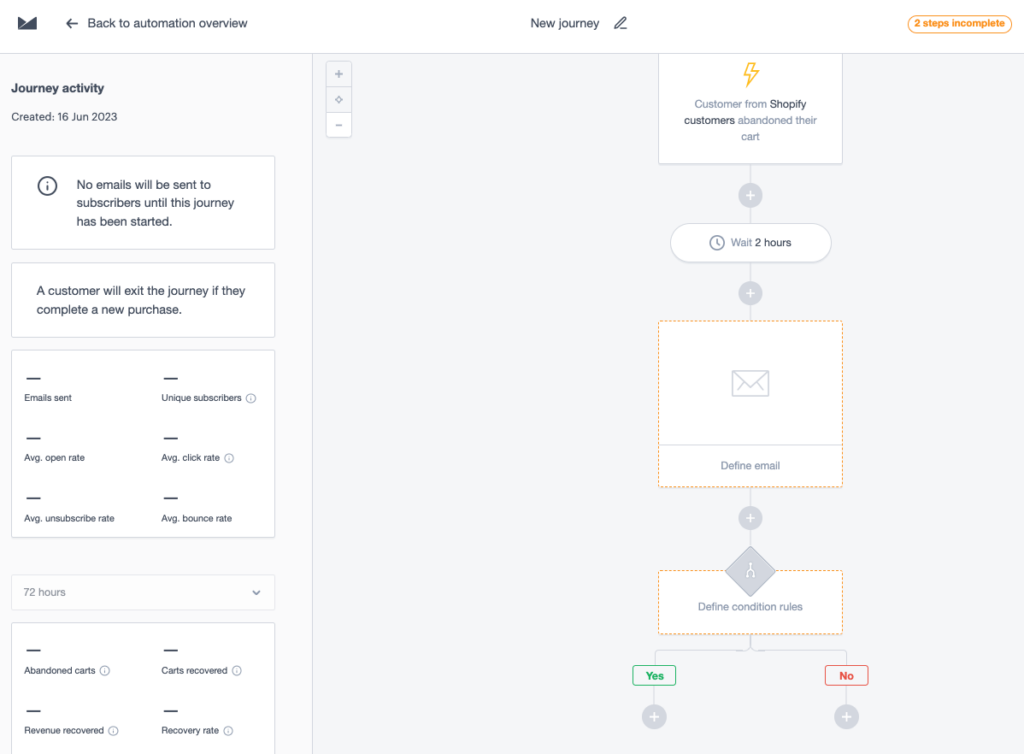
On the other hand, Campaign Monitor’s automation part is user-friendly but very basic. The only prebuilt workflow is a welcome email. Moreover, this platform offers a more limited set of triggers, including:
- When a subscriber joins the list
- When a subscriber enters or exits a segment
- With a specific date
- When an order is paid
- When a cart is abandoned
Overall, we found Constant Contact’s marketing automation not as robust as Klaviyo, ActiveCampaign, or Omnisend. But it can be sufficient for a lot of ecommerce businesses.
Meanwhile, Campaign Monitor could improve their automation part by adding more triggers on email engagement, on-site behavior, and purchasing behavior.
Constant Contact wins this round with more ready-to-go workflows and automation triggers.
Signup forms and landing pages
Regarding template offerings, both Constant Contact and Campaign Monitor provide basic form designs with limited customization options.
Constant Contact offers a range of signup form options, including
- Popups
- Flyouts
- Banners
- Inline forms
- Lead generation landing pages
- Facebook lead ads
On the other hand, Campaign Monitor offers fewer choices, such as a signup page, a simple popup, and code integration for embedding forms into websites.
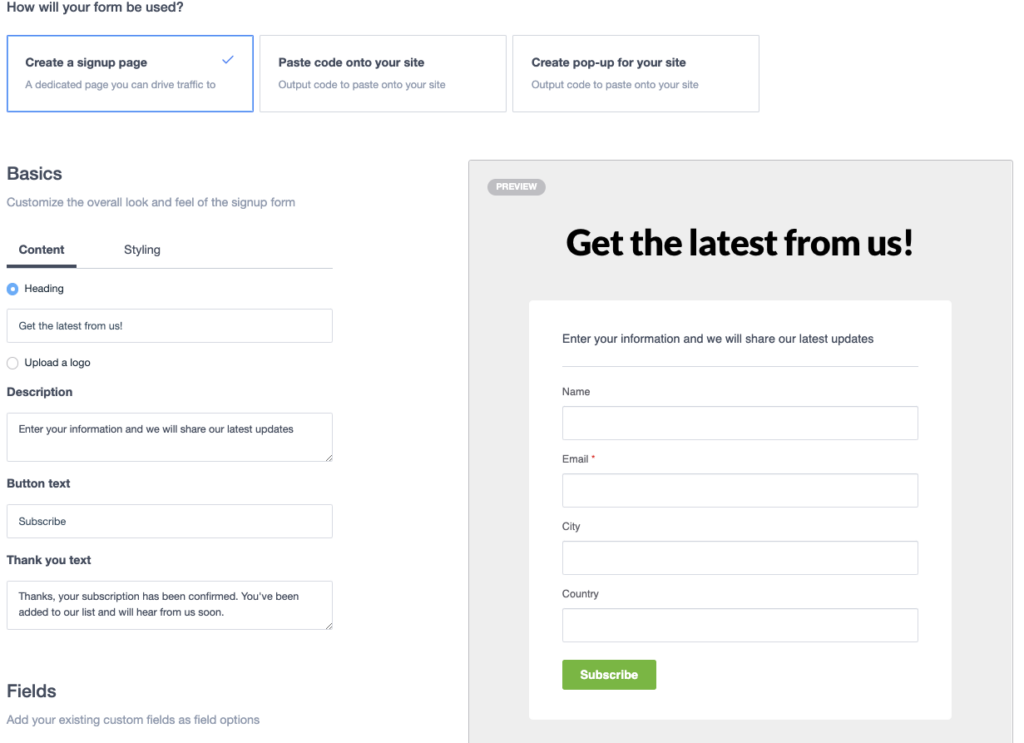
In terms of analytics, Constant Contact provides tracking capabilities to measure signup form performance, including metrics like the number of submissions and conversion rates. In contrast, Campaign Monitor lacks analytics for signup forms.
Moving on to list management, Constant Contact simplifies the process with functions like tagging, lists, and segments. Importing data and mapping fields is intuitive. In comparison, Campaign Monitor offers straightforward list management with easy import tools and mapping, but locating segments within the tool proved more challenging.
Overall, both tools performed below average in this section, lacking template options for signup forms and landing pages. Users critique Constant Contact’s form builder for its limited flexibility, expressing a desire for more layout choices and the ability to add images in different locations.
Constant Contact emerges as the winner in this round with a broader range of signup form options, analytics capabilities, and a dedicated landing page builder.
Segmentation
Constant Contact or Campaign Monitor? It might just depend on how targeted you want your emails to be.

Constant Contact offers four ready-to-go audience segments based on customer engagement levels. They are:
- Most engaged
- Somewhat engaged
- Least engaged
- Everyone else
However, these segments aren’t specific and don’t give much insight into the subscriber, making them not so useful for an advanced segmentation strategy.
As for Campaign Monitor, you only get pre-built engagement segments on the highest-tier payment plan. Other segment options include subscriber details, custom fields if you have them, and campaign activity.
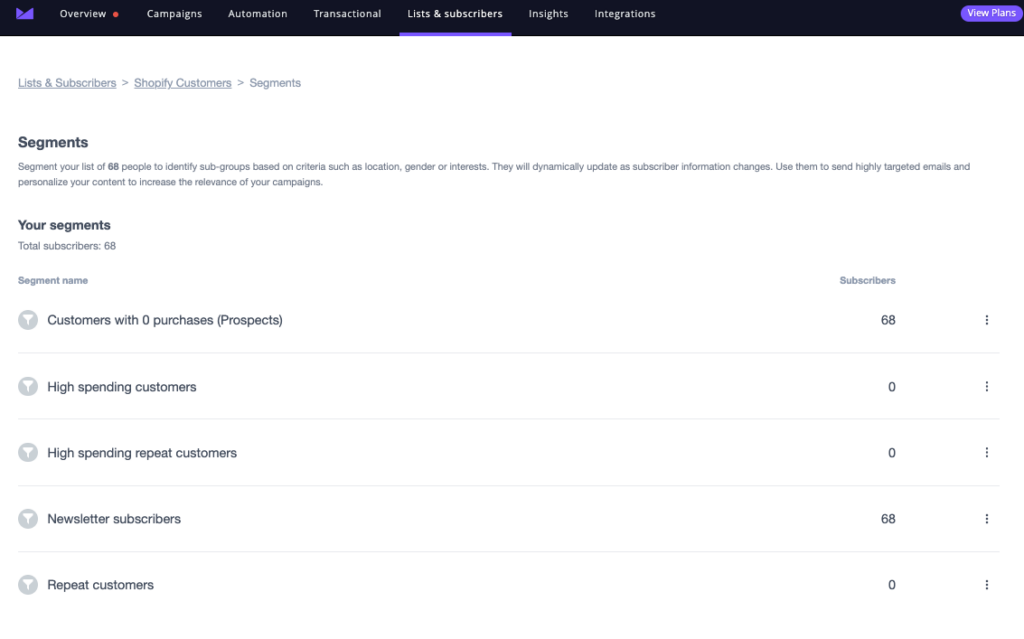
Constant Contact has a bit more segment options. It has a list of membership, contact details, tags, contact email activity, ecommerce activity—placing an order, amount spent, number of orders, and more. Yet, the segmentation options fall short compared to other tools in the market.
Overall, Constant Contact could provide more clarity with its pre-built audiences. It isn’t clear what “Somewhat engaged” means. More pre-built segments would also be good, and the onsite behavior criteria for segmentation. In Campaign Monitor, it’s segmentation on purchase behavior that’s missing.
Constant Contact wins this round by a slight margin. Although it could be clearer with its pre-built segments, it offers the same for lower-tier plans, unlike Campaign Monitor. Also, Constant Contact has more segment options to pick from.
Analytics
Both Constant Contact and Campaign Monitor offer insights into your marketing campaigns.
Constant Contact provides reports on your overall email campaign performance. The tool tracks metrics such as sends, opens, clicks, bounces, and unsubscribes. In the automation section, you can view the number of subscribers in the workflow, revenue generated, the number of conversions, and the conversion rate.
In addition, you can see some trends over time, insights from the conditional split, and email engagement rates. You can reach your campaign results on the web or you can download Constant Contact’s mobile app for iPhone and android to check your insights on your mobile phone.
Campaign Monitor, on the other hand, only offers basic email campaign analytics. You can track opens, clicks, delivery rates, bounces, devices, locations, etc. A bit less data than Constant Contact.
Overall, ecommerce insights for email campaigns are missing with both tools. We couldn’t find heatmaps, revenue per campaign, and other essential data for ecommerce.
Constant Contact is the clear winner in this round.
Customer support
Constant Contact offers a comprehensive range of customer support options, covering almost every avenue available.
Options include:
- Phone support, where customers can directly speak with a representative to address their concerns
- Live chat support, enabling real-time interaction with support agents for immediate assistance
- Email support, allowing customers to send their queries or issues and receive timely responses
Constant Contact customers can also access various self-help resources, such as:
- A value-packed help center. This resource hub contains a wealth of information, FAQs, and guides that address common questions and provides step-by-step instructions
- Webinars, which offer in-depth tutorials and guidance on different aspects of their services
- Onboarding calls and personalized sessions to help customers get started with the platform.
- Informative blog posts and video tutorials
These resources cover a wide range of topics, from best practices in email marketing to tips for improving engagement and conversion rates. With such a diverse range of customer support options, Constant Contact ensures that users have access to the assistance they need, regardless of their preferred method of communication.
On the other hand, Campaign Monitor falls short in comparison, as it only offers email and phone support exclusively for its highest-tier users. While these options can be useful, they may not be as convenient or timely as other forms of support. Campaign Monitor also lacks live chat support, which can be a valuable means of resolving issues quickly and efficiently.
However, Campaign Monitor does provide several learning resources to help users educate themselves.
- Their email marketing academy serves as a hub for comprehensive learning materials, offering in-depth courses and tutorials to enhance users’ email marketing skills
- They also have a help center that houses articles and guides to assist users in navigating their platform effectively
- Plus, Campaign Monitor maintains a regularly updated blog with informative posts and hosts webinars to provide additional insights and knowledge
Constant Contact wins this round. It offers more support overall.
Integrations
Integrations help you make the most of your email marketing efforts.
When comparing Constant Contact and Campaign Monitor, it’s crucial to take into account the significance of integrations.
Constant Contact offers an extensive library of over 300 integrations, including:
- Canva
- Vimeo
- Salesforce
- Eventbrite
- Gmail
- WordPress
- Google Ads
- Facebook Ads
- Shopify
- Stripe
- WooCommerce
With Constant Contact’s diverse range of integrations, users can seamlessly connect with popular platforms, expanding the functionality and effectiveness of their email marketing efforts.
Campaign Monitor offers a decent list of over 100 integrations spanning list building, CRM, ecommerce platforms, advertising, and other tool categories.
Some brand names Campaign Monitor integrates with include:
- Salesforce
- WordPress
- Shopify
- Unbounce
- Intercom
- OptinMonster
- AdRoll
- HubSpot
- Flexer
- Gift Up!
- GrowSurf
Constant Contact takes the lead with a bigger list of integrations.
Compatibility with other marketing channels
Compatibility with other marketing channels allows you to reach a larger audience and engage with them through different communication points, other than email.
Constant Contact offers integrations with popular social media platforms like Instagram, LinkedIn, and Twitter. This allows you to connect and engage with your audience across various channels.
Additionally, for users in the United States, Constant Contact supports SMS marketing, enabling you to reach customers through text messages.
Furthermore, Constant Contact provides the capability to run advertising campaigns through Google Ads and Facebook Ads, allowing you to expand your reach and target specific audiences.
Campaign Monitor has recently introduced SMS functionality to their platform. However, they currently don’t have standardized offers for SMS quotas and pricing plans. It’s important to note that SMS services are currently only available for users in the United States.
Constant Contact, once again, takes the lead by integrating with a wider range of marketing channels.
Price Comparison
Price is always crucial when choosing an email marketing platform.
With pricing, it’s important to consider not only the surface-level cost but the features and capabilities you get at different price points. Most importantly, consider what those features are worth to your business’ bottom line.
This mind frame will help you make the better choice.
Both Campaign Monitor and Constant Contact offer 14-day free trial periods. The table below is a closer look at their paid plans.
Conclusion: Which one wins?
Below is a comparison table highlighting the strengths and limitations of Campaign Monitor and Constant Contact:
4
3.6
Free plan – No
500 subscribers – $12
1,000 subscribers – $30
5,000 subscribers – $80
10,000 subscribers – $120
50,000 subscribers – $430
50,000+ subscribers – Custom pricing
Free plan – No
500 subscribers – $9
1,000 subscribers – $29
5,000 subscribers – $49
10,000 subscribers – $89
50,000 subscribers – $299
50,000+ subscribers – Custom pricing
- Easy to get started
- Great customer support
- Great compatibility with other marketing channels
- Easy to use
- Simple navigation
- Beautiful email templates
- Real-time reporting analytics
- Basic signup forms and landing pages
- Basic analytics and reporting
- Lacks ecommerce insights
- No signup form templates
- Pricing is on the high side when you factor in features offered
- Ecommerce beginners
- Bloggers
- Non-profit organizations
- Solopreneurs
- Bloggers
- Non-profit organizations
- Well-established ecommerce businesses
- Lifestyle bloggers
- Ecommerce businesses
After a thorough comparison between Constant Contact and Campaign Monitor, the final verdict is in:
Constant Contact emerges as the clear winner in all aspects. It secured victory in all 9 rounds, showcasing its superiority over Campaign Monitor’s features.
Constant Contact excels in various areas, including its user-friendly interface, comprehensive customer support, and compatibility with diverse marketing channels. Furthermore, it offers these advantages at a more affordable cost compared to its counterpart.
Despite its decisive victory, Constant Contact does have a limited number of advanced ecommerce-specific features, which can be advantageous for ecommerce business owners seeking success with email marketing. Other leading platforms like Klaviyo, ActiveCampaign, and Omnisend are better suited.
In summary, Constant Contact is an excellent email marketing platform, particularly well-suited for ecommerce beginners, bloggers, non-profit organizations, and solopreneurs. Its overall performance, combined with its competitive pricing and comprehensive support, solidifies Constant Contact as the preferred choice in this comparison.
Read full reviews
Related picks for you
Our team strives to be accurate and unbiased in reviewing email tools. However, we recognize that mistakes can happen, and it’s essential for us to stay up to date. If you come across any errors or things that need to be reviewed again, please let us know.




